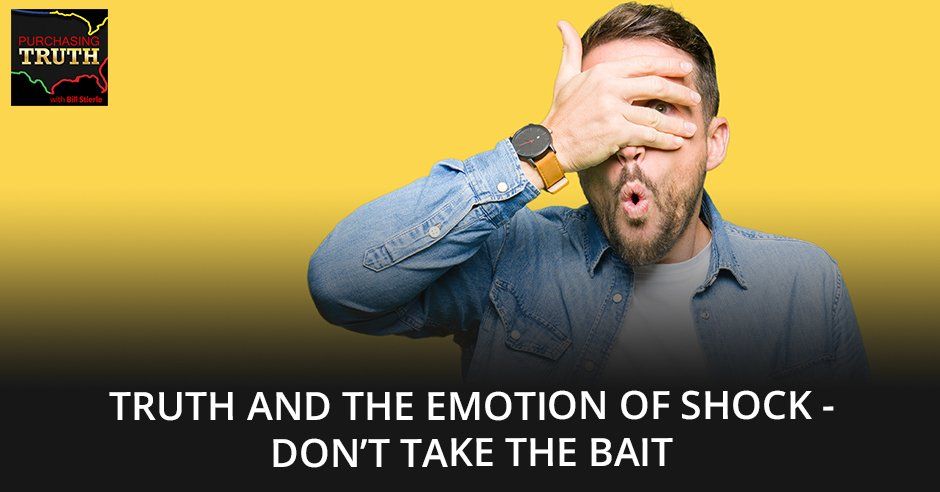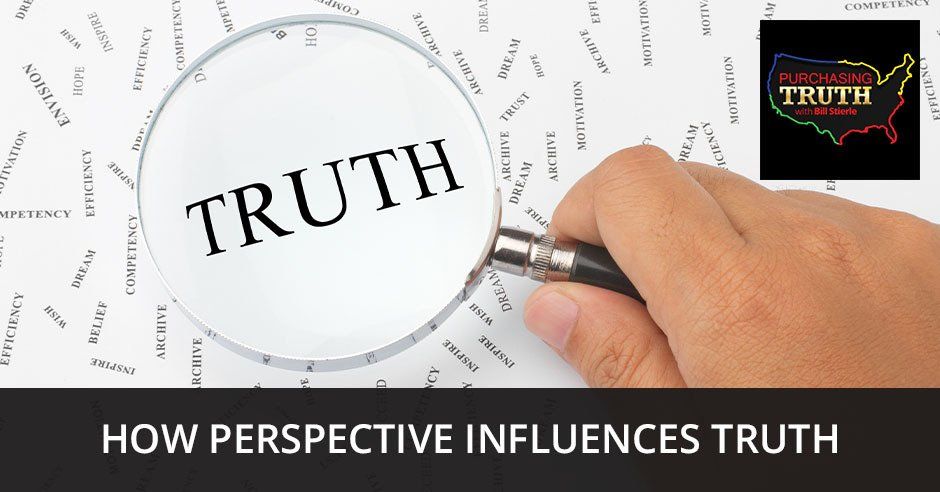Truth Vs. Facts
Subscribe Today!
With the ease and accessibility of different media platforms, being a victim of fake news isn’t anything new, whether it’s political, religious, or the life of celebrities. The truth which was once absolute can now be bent and changed. Bill Stierle and co-host Tom talk about the real-life effects when the truth is obstructed from the public eye. This episode covers how people of influence have used this strategy to gain favorable outcomes for their party. Bill and Tom also touch on how publicity and the media play big roles in why the facts are being altered and sometimes even hidden.
---
Bill, there’s so much going on in the media daily, in our culture and in our political world. There are so many things we could talk about each day but one jumped out at me, which Joe Biden is speaking at the Iowa State Fair. There are many things to read into this but he’s quoted talking about the Democrats he said, “We choose unity over division. We choose science over fiction. We choose truth over facts.” It’s the truth over facts that I was half-asleep when I saw this on my news program and then I perked up. I’m like, “What was that? Rewind that.”
That’s a good one to rewind. Our whole show is all about how to deal with the truth. It’s for him to put facts and truth in some polarity to them. We’ve done many wonderful episodes and this is for people to go back and read about a thing called truth perspective. It’s a partial truth but it’s a belief that might be outdated or a belief that we have more evidence around. Truth versus fact is not a good two things to set in opposition with each. They can’t be. Truth and facts have to have some relationship to each other. That’s a big challenge.
When I first heard him say this, I thought it was another Joe Biden gaffe. He is prone to tripping over his words, misspeaking here and there. It was not truly a belief of his, but he misspoke when he was comparing poor kids to white kids. He meant to say poor kids to rich kids. That was misspeaking. On this one, I thought it was misspoken at first but apparently not. He was trying to put truth and facts opposite each other which doesn’t make a lot of sense to me.
It doesn’t. Further discussion about this as time goes by, spokespeople are going to try to cover around that. It’s a longer discussion about the relationship between truth and facts unless they got the skills I got about how to parse what truth is, also to stay in a place of curiosity about somebody stating a belief as a fact. How do you know if it is? This is where Donald Trump has done a wonderful, tragic job of being able to claim truth by holding the megaphone up to the things he wants and no detractions for the things he doesn’t want to clean up. He is a kid going through the aisle of a toy store and pulling the toys down and he keeps walking and everybody else has to clean the toys up.
That’s an incredible mental picture.
It is, “Look at this toy. It’s a great toy and he tosses it on the ground. “Look at this other toy,” and you’re like, “Mr. President, don’t you see the toy you toss on the ground? Aren’t you going to put it on the shelf?” “No, the white nationalist, there’s no such thing. It’s fake media, fake news. It’s not true, don’t believe it. This is rigged,” and he takes another toy down.
It’s that toy something he’s serving to the base? Are the toys for the white nationalist? Is that the idea?
The way to think about this is an exercise in sales and marketing. An exercise of, “Here is something that is a shocking reward for the people who are loyal to me to believe.” When you come back after a commercial break, there will be something that’s going to be revealed. After the commercial break, there will be something else that’s going to be revealed. That is his training as a reality star, he has to set it up and as a marketing salesperson, and it’s always about the reveal. It’s not like the other newscasters don’t do it too. Rachel Maddow does it, “Right after the message. We’ll be right back.” It’s called the hook on the radio. They do it, “Right after the commercial break, wait until you see what’s happening on the other side.” On a scale of 1 to 10 is it big? It might not be, but that’s not what the body tells the person to do. The person tells the body to stay loyal to the radio station, to Rachel Maddow and to Donald Trump. Why? Because of the physiological hook that goes into it.
Is this what you would call the anticipation is building and somewhat of the uncertainty where he always says, “We’ll see what happens.” That’s one of his biggest cliché phrases.
That’s correct. I want the media to say, “The President is using anticipation for what he thinks is going to come next and he’s building anticipation that he might have and it’s something. I feel doubtful and skeptical that he does.” They’re allowed to do that and still be newsworthy. “I feel doubtful and skeptical. He has a new medical plan. I feel doubtful and skeptical that there is something or otherwise we would be able to see something already. I feel hesitant and nervous about the need for integrity is met with that statement.” They’re becoming a truth advocate instead of a responsive media. I almost called them call girls because there is a call girl principle in alignment here. You know the call girl principle, have you ever heard of it?
I haven’t heard it said quite that way can you eliminate that for me?
I’m happy to do it. The call girl or the prostitute regrettably, they get their money before the service is rendered, not after. As soon as the service is rendered the value depreciates very quickly. After an orgasm, there’s depreciation. It’s not all that valuable. It wasn’t that good and the user might say, “No sorry, we don’t give refunds.”
You pay before the reward is given because the idea of the value of the reward is often better than the actual reward.
CLICK TO TWEET
It gets people running back to what they feel were safe.
I would’ve doubled down on my loyalty to this guy. Every time the media is shaken, “I don’t understand why his points went up?” Because you’re talking about it in a way that creates more anticipation instead of less anticipation. The more you nurture and empathize with the things that Donald Trump says, the less power he will have.
That is counterintuitive but I certainly believe it. Everything we’ve talked about and the multiple episodes that we have recorded and also my training with you over sales and communication, I’m convinced you’re right.
All the candidates are doing it like Elizabeth Warren and Kamala Harris. Pete Buttigieg gets out of the corner quicker than most people do. Joe Biden walks into it and paints himself in the corner and Bernie Sanders. What they don’t realize is they’re repeating the mantra that his people already know of him, instead of the mantra of what a leader needs to do. That’s what’s missing. “We know where you stand and you’re calling them a liar. You did that the last 50 times I’ve seen you. Could you please give me a new message?”
I agree with you. Pete Buttigieg does the best job of leading as opposed to repeating the same sound bites or headlines over and over again. Ironically, he’s the youngest candidate being the adult in the room. Let’s come back to Joe Biden. It’s great to set up what the President does so skillfully and so well. Even though to many people, it appears like a train wreck of leadership and it may very well be. Let’s bring this back to Joe Biden, saying, “We choose unity over division. We choose science over fiction. We choose truth over facts.” How is that communication not helpful to him? How is that a tragic opposition of issues?
There are three major things that are problematic. Number one, you’re assuming you’re speaking to people that are college-age or post-college age to have those complex phrases altogether. This is Gettysburg Address moment, “Four score and seven years ago.” You’ve got to talk to the people where they are. This is where they are. You can’t talk to them where you’ve been. Donald Trump is good at that because that’s what TV reality show is. Speak at the fifth-grade level. It’s not to say that the people that are listening are at the fifth-grade level or have that mentality. No, there’s plenty of smart people that get hooked on the same thing. Joe Biden’s best narrative is that, “Leadership to me looks like, integrity to me looks like,” and then put a statement on the back end of it. He’s got something that he starts occupying the space.
One of the things that Barack Obama did that separated him from the pack and allowed him to run away from Hillary Clinton very easily. It allowed him to wreck. With a name like that to get elected and he still got elected, what did he do that was different? He kept leading ahead of where everybody else was. The discussion was all about Iraq. He went, “The origin of this war started in Afghanistan and here are the seven things I do or five things I would do with Afghanistan. This is where the fundamental part of terrorism is and we’re not noticing that here.” He pivoted and all of a sudden, the Republicans and everybody were clamoring the same thing on the bailout.
$700 billion is going to take care of this. I watched him walk across the Senate floor, come up to the thing and said, “Senators, this is what it’s going to take to do it.” He knew very well that it was going to take another $300 billion but he knew he could get $700 billion. Everybody had to follow that number. The Republicans couldn’t bring it down. The Democrats couldn’t bring it up to tell the truth, but after he got elected, the $700 billion went to bailout the thieves at Wall Street and the banks that stole all the government money. We had to prop all them up while everybody else is sucking eggs. They were supposed to lend the money out. No, they put new tellers in. They put new banks. They redid their ATMs. The main thing is pivoting, turning and standing because if you get stuck and talking about the last story, you’re going to get dinged.
You’re going to then get stuck arguing facts. As we know, you can sit here arguing facts all day long and you may very well be right about the facts but you’re not going to get anybody’s attention, no one’s going to care. That’s where Joe Biden’s argument, “We believe in truth over facts,” that didn’t make any sense to me. You don’t want to appear like facts are your enemy and truth is an opposition to facts. That’s almost worse than what the media does who’s always focusing on fact-checking, which again is not going to be a productive narrative.
That brings up something important. I’m glad you brought that. If the media started scaling facts and started scaling perceptions, on a scale of 1 to 10 it’s about a 7. This is about a three-issue. “The numbers for this is this, yet the popularity of the belief is this.” What would happen is that there would be greater trust in what the media is saying because they’re coming down too much in a black and white world. It’s almost like they need to offer the range of, “This is what a blatant lie is” or “On a scale of 1 to 10, this is about a level-3 truth.” It would be true to the people that are loyal and believe in him but for the people that don’t, it’s more like a seven of an untruth. You can start calling it truths and untruths or partial truth and mostly true or less true and throw a percentage on it.
It would be very helpful. They’d be wise to get ahold of your truth scale. Can you imagine if they understood and if somebody in the media understood and communicated this to a larger amount of the US viewership, they then could point out, “Here you could see Donald Trump again calling him Sleepy Joe. He’s down here and labeling diagnosis. He’s getting further away from truth.” If that was part of the discussion then those labels that the President is serving up on an almost daily basis would have much less impact. It would almost cease being newsworthy.
You could even empathize with President Donald Trump. “Sleepy Joe,” maybe the President might be tired or feeling fearful or anxious about Joe Biden speaking up with such confidence.
It is like, “What happened?”
90% of the speech was confident. There were two or three moments where the messaging wasn’t right. The media amplifies that or the alternate media amplifies that. What happens is it starts to occupy the truth. A 10% gaffe will easily cover a 90% perfection.
We’re going to continue to see him as the tortoise in this race. We’re going to continue to see Mayor Pete Buttigieg continue to rise. Whether he gets the nomination or not, I don’t know. That remains to be seen. He is someone that is much more skillful in how he talks about things. He does have some of those “What just happened here” moments. He doesn’t get stuck in the labeling and diagnosis in particular that you see other candidates are saying. If somebody asks him, “Do you think the President is a racist?” Watch how he answers and pivots. He doesn’t say it exactly like you do, “We need to have a President that has more respect for different cultures and respect looks like this or respect might look like this,” but what he’s saying gets there.
It gets there and there’s an inclusion piece that he often uses, which is refreshing too. It’s that you can’t make an enemy out of somebody that you’re trying to eventually win over or eventually doesn’t become. It’s like a disgruntled employee coming back to an upset thing and doing something terrible coming back to a work site. You want to leave the relationship where it ends in a very clean way. You don’t want it to let it end in a way that is going to allow the person to ruminate violence. The violence is they become an advocate for the opposite side and they don’t need to be. Tom, you and I both know how to extend mutual respect to each other. I’m guessing within a very short time if we include the worst of the worst, we could still see the person’s humanity in the tragic behavior that they say and do.
I can also see areas in which people I disagree with on many levels can have areas of common ground. I can see the potential there. It’s very interesting and it seems like you’re saying, “Having empathy and showing some respect for the people, some compassion for the people you disagree with allows them to come back later.” Whereas the way others are speaking it’s like back to the Hillary Clinton and the deplorable comment that what it did in effect is burned a bridge between a large portion of American voters to the point where much as they maybe didn’t like President Donald Trump, they could not see themselves following Hillary Clinton. That was a bridge she burned so that she made sure they didn’t.
Mitt Romney had one of those moments where the guy was videotaping him. The 47%, he has one of those moments. That moment swung 10%, 15% of the vote away from him because we’re Republican and you’re talking to the rich part of the Republicans and that’s all you’re here for.
It turned off people that might have been in the middle and might have come his way where he said that 47% of Americans are dependent on government in some form. That was paraphrasing essentially what he said. Republicans, in general, are supposed to be the smaller government party. They don’t like people being dependent or the idea of people being dependent on government but you’ve got an awful lot of conservative voters out there. They’re dependent on the government and that turned people away.
Much of the social service supports that our government provides to ex-military people. Every time they talk about the handout and this thing like, you’re talking about the military people that have served the country and you didn’t leave them off at the end with a good job. You didn’t leave them off better. You stuck them back into society and said, “Fend for yourself and here’s a little bit of food, but it’s not going to last too long.” It’s one of the lowest integrity things that regrettably our government and/or Republican colleagues do is cut those interpersonal, social service pieces. All the way back to Ronald Reagan and all the cutting he did to put all the homeless people on the street, he started it. There was a time in the late ‘70s where the food was being distributed to the shelters in such an efficient way that people weren’t hungry. There was a low percentage of people. Now, 40% of the food we make, we throw away. What kind of noise is that?
It doesn’t always get to all the people that could use it. I have a personal experience with the Orange County Second Harvest Food Bank. They’re doing a lot here in Southern California. They distribute food to those that need it but there is a tremendous need, is the point.
You got to make it mandatory that the food that is expired or moving out needs to be distributed to these people and it would start getting there. It’s not mandatory because it’s cheaper for them to throw it out. Tom, we got a lot of truth issues that we need to work on, don’t we?
Always it seems, yes.
These are good fact pieces and this is why the facts versus truth is not an equal sentence. Here is the fact and even you and I talking about homelessness or things, all I got to do is put one or two globalizing words and the argument will come like a flame thrower at me. All homelessness, if I do an always, a never, should or shouldn’t, immediately the flame thrower is going to come in my direction because they’ll find the 1% that it’s not true and say, “See.”
The proportionality of everything gets lost. All of a sudden, if I find one fact that is in opposition to that sweeping statement you made, it questions the whole thing.
Climate change gets to be thrown out, even though 2% of the people say it’s a hoax. What the heck is that noise? This has been a good one, Tom. Next time, we want to take on a little bit about how the criminal system needs to restore trust and truth. What’s the cost of a truth message? If you go with the truth then what is the cost. There are a lot of problems that we have in our system of people hiding things. They don’t want the truth to come out and because they hide things, then the truth gets stuck. They’re not interested in truth. They’re interested in protection.
I’m interested to discuss that in context with perhaps the President’s income tax returns. Doesn’t that fall into that protection message?
It is a protection message. It’s also one of the things that he’s done a wonderful job of planting seeds of doubt inside his loyalists, his voters’ minds that it’s no big deal, “I’ve always been a rich guy. This is the way it works. I’ve been audited. I got audited many times. The audits aren’t always right. They’re always changing the numbers. It’s no big deal.” It’s all the same shell game of anticipation that you place.
Talk about baiting the hook for next time.
That’s a good one. Thank you very much. I appreciate it. Tom, it’s a lot of fun.
Thanks, I had a great time.
Important Links:
Love the show? Subscribe, rate, review, and share!









